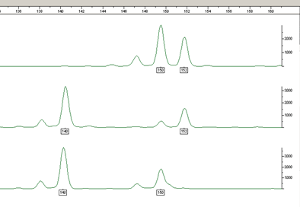

The genetic variation which is present in an animal, originates from both parents. Half of the variation is originating from the father, whereas the other half comes from the mother.
For parentage verification, typically 20 up to 40 genetic characteristics are visualized. In this process the length of genetic fragments is being measured. The measured length of a genetic characteristic in an offspring must correspond to the length in the mother and father that were provided for comparison. In two examples, it is shown how the basic rules are applied in parentage verification.
In the figure an example is provided of a correct parentage. In this figure, the DNA is shown of three individuals: an offspring (upper line), a potential mother (middle line), and a potential father (bottom line). In each line one genetic marker is shown. Two DNA fragments are visible as peaks. The first fragment of the offspring is originating from the father (length of the fragment is 150), whereas the second fragment comes from the mother (fragment length 152). In this case both fragments of the offspring are present in the parents: the parentage is correct.
In the second example a situation is shown where parentage does not qualify. The three lines are shown in the order of offspring, potential mother and potential father. Again in each line one DNA marker is shown, where two DNA fragments are visible as peaks. The second fragment of the offspring is present in the mother (fragment length 152), whereas the first fragment in the offspring (fragment length 150) is NOT present at the assigned father. In this case, one fragment is present at the offspring, which is not present in either of the parents: the parentage does not qualify.
When 20 up to 40 different genetic fragments are checked, the chance that an incorrect parentage is not detected becomes very small. The genetic fragments which are used for parentage verification and identification provide no information on properties such as color and quality of an animal, plant or human, since the fragments are non-coding.
When the length of a number of DNA fragments is measured for a sample, a DNA-profile is established. This pattern is unique for a specific individual person, animal or plant, so that in cases of doubt DNA-profiles can be compared to confirm if two samples originate from the same individual.